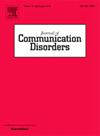Perceptual and acoustic predictors of speech intelligibility among Hebrew-speaking young adults with down syndrome
IF 2.1
3区 医学
Q2 AUDIOLOGY & SPEECH-LANGUAGE PATHOLOGY
引用次数: 0
Abstract
Background
Down syndrome (DS) is a common chromosomal disorder associated with various speech impairments, including reduced intelligibility. While speech subsystem deficits in DS have been documented, their relative influence on intelligibility remains understudied, particularly in non-English speaking populations. This study investigated speech intelligibility and select subsystem functioning in Hebrew-speaking young adults with DS, aiming to describe the speech production disorder and identify predictors of single-word intelligibility in this population.
Methods
Twenty-four adults with DS and 24 typically developing (TD) peers produced common single words in Hebrew. Perceptual and acoustic analyses were conducted on select speech subsystems, including articulatory (consonant and vowel production) and phonatory measures.
Results
Speakers with DS had higher error rates for complex consonants and demonstrated vowel space centralization compared to TD peers. Group differences were observed in most acoustic vowel measures, with interactions with speaker gender, but only select acoustic voice measures. Stepwise regression analysis identified three significant predictors of single-word intelligibility in the DS group, namely Percentage of Consonants Correct (PCC), Jitter (ppq), and average ellipse size of vowel clusters within the acoustic vowel space.
Conclusions
These findings highlight the complex nature of speech intelligibility deficits in individuals with DS, emphasizing both articulatory and phonatory contributing factors. The results also suggest potential cross-linguistic differences in subsystem contributions to intelligibility. Clinical implications include the need for comprehensive assessment and targeted interventions addressing multiple speech subsystems in this population.
在说希伯来语的唐氏综合症的年轻人中,言语可理解性的知觉和声学预测因子
唐氏综合症(DS)是一种常见的染色体疾病,与各种语言障碍有关,包括可理解性降低。虽然有文献记载了失语症的语音子系统缺陷,但它们对可理解性的相对影响仍未得到充分研究,特别是在非英语人群中。本研究调查了讲希伯来语的年轻成年DS患者的语音可理解性和选择子系统功能,旨在描述该人群的语音产生障碍并确定单字可理解性的预测因素。方法24名发育正常(TD)的成年人和24名发育正常(TD)的同龄人用希伯来语说出常见的单字。对选择的语音子系统进行了感知和声学分析,包括发音(辅音和元音的产生)和发音措施。结果DS患者在复杂辅音发音上的错误率高于TD患者。在大多数声学元音测量中观察到群体差异,并与说话者性别相互作用,但仅选择声学语音测量。逐步回归分析发现了DS组单字可理解性的三个显著预测因子,即辅音正确率(PCC)、抖动(ppq)和元音空间内元音簇的平均椭圆大小。结论:这些发现突出了退行性残疾个体言语理解缺陷的复杂性,强调了发音和发音两方面的影响因素。结果还表明,子系统对可理解性的贡献可能存在跨语言差异。临床意义包括需要对该人群的多个言语子系统进行综合评估和有针对性的干预。
本文章由计算机程序翻译,如有差异,请以英文原文为准。
求助全文
约1分钟内获得全文
求助全文
来源期刊

Journal of Communication Disorders
AUDIOLOGY & SPEECH-LANGUAGE PATHOLOGY-REHABILITATION
CiteScore
3.30
自引率
5.90%
发文量
71
审稿时长
>12 weeks
期刊介绍:
The Journal of Communication Disorders publishes original articles on topics related to disorders of speech, language and hearing. Authors are encouraged to submit reports of experimental or descriptive investigations (research articles), review articles, tutorials or discussion papers, or letters to the editor ("short communications"). Please note that we do not accept case studies unless they conform to the principles of single-subject experimental design. Special issues are published periodically on timely and clinically relevant topics.
 求助内容:
求助内容: 应助结果提醒方式:
应助结果提醒方式:


